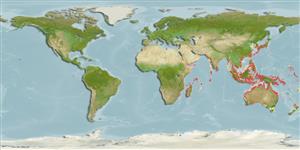Environment: milieu / climate zone / depth range / distribution range
Ecología
marino; salobre asociado a arrecife; rango de profundidad 2 - 20 m (Ref. 90102). Tropical
Indo-West Pacific: western India to Indonesia; south to northwestern Australia.
Tamaño / Peso / Age
Maturity: Lm ? range ? - ? cm
Max length : 35.0 cm TL macho / no sexado; (Ref. 9710)
Short description
Morfología | Morfometría
Espinas dorsales (total): 1; Radios blandos dorsales (total): 48-50; Radios blandos anales: 58 - 62.
Inhabits sandy weedy areas of coastal reefs (Ref. 9710). Lives in open muddy substrates in estuaries as well as deep coastal bays. Usually found lining up with ropes, seawhips and large stringy-type sponges. Incredible mimic that may float over the open bottom like a mangrove-shoot, may stand on its head (Ref. 48637). Enters mangroves (Ref. 9710).
Life cycle and mating behavior
Madurez | Reproducción | Puesta | Huevos | Fecundidad | Larva
Allen, G.R. and R. Swainston, 1988. The marine fishes of north-western Australia: a field guide for anglers and divers. Western Australian Museum, Perth. 201 p. (Ref. 3132)
IUCN Red List Status (Ref. 130435)
Threat to humans
Harmless
Human uses
Pesquerías: escaso valor comercial
Más información
Nombres comunesSinónimosMetabolismoDespredadoresEcotoxicologíaReproducciónMadurezPuestaAgregación para la puestaFecundidadHuevosEgg development
ReferenciasAcuiculturaPerfil de acuiculturaRazasGenéticaElectrophoresesheritabilidadEnfermedadesProcesamientoNutrientsMass conversion
ColaboradoresImágenesStamps, Coins Misc.SonidosCiguateraVelocidadTipo de nataciónSuperficie branquialOtolitosCerebrosVisión
Herramientas
Special reports
Download XML
Fuentes de Internet
Estimates based on models
Preferred temperature (Ref.
123201): 24.7 - 29.3, mean 28.5 °C (based on 3053 cells).
Phylogenetic diversity index (Ref.
82804): PD
50 = 1.0000 [Uniqueness, from 0.5 = low to 2.0 = high].
Bayesian length-weight: a=0.00589 (0.00232 - 0.01492), b=3.07 (2.85 - 3.29), in cm total length, based on LWR estimates for this (Sub)family-body shape (Ref.
93245).
Nivel trófico (Ref.
69278): 2.8 ±0.4 se; based on size and trophs of closest relatives
Resiliencia (Ref.
120179): Medio, población duplicada en un tiempo mínimo de 1.4-4.4 años (Preliminary K or Fecundity.).
Fishing Vulnerability (Ref.
59153): Low vulnerability (25 of 100).
Nutrients (Ref.
124155): Calcium = 47.1 [18.6, 116.0] mg/100g; Iron = 0.592 [0.262, 1.338] mg/100g; Protein = 18.2 [16.1, 20.6] %; Omega3 = 0.08 [0.03, 0.17] g/100g; Selenium = 30.1 [13.7, 69.2] μg/100g; VitaminA = 73 [25, 213] μg/100g; Zinc = 1.74 [1.12, 2.75] mg/100g (wet weight);
